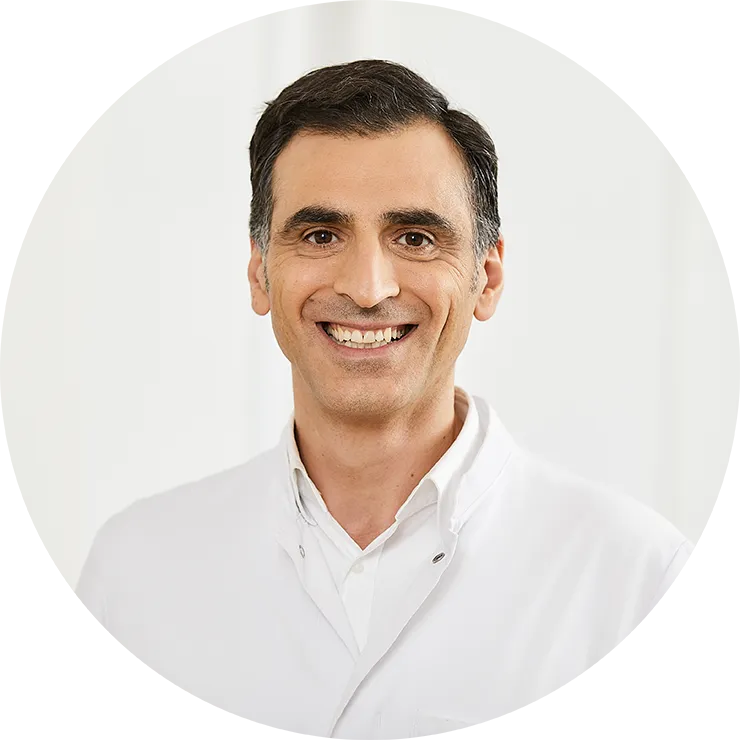Ihr IFT Centrum in Hamburg
Intraoperative Faszientraktion (IFT): Innovation bei sehr großen Hernien
Intraoperative Faszientraktion (IFT) – was ist das? Warum ist die OP bei großen Bauchwandhernien so komplex? Welche Rolle spielt das Hamburger Hernien Centrum bei der Entwicklung des Verfahrens? Erste Antworten finden Sie hier – Details erklären wir Ihnen in unseren Sprechstunden in Hamburg.
Auf einen Blick:
- Die intraoperative Faszientraktion (IFT) kommt bei sehr großen Bauchwand- bzw. insbesondere Narbenhernien zur Anwendung. Das innovative Verfahren ermöglicht den schonenden, spannungsarmen Verschluss sehr großer Hernien. Aufwändigere mit größeren Risiken verbundene Verfahren können so vielfach umgangen werden.
- Erstmals wurde das Verfahren von Dr. Dietmar Eucker unter dem Namen AWEX („Abdominal Wall Expander System“) angewendet und dann von Prof. Henning Niebuhr, Dr. Halil Dag und Team gemeinsam mit Dr. Gereon Lill zur spezifischen Anwendung in der Hernienchirurgie entscheidend weiterentwickelt und verfeinert.
- Im Hamburger Hernien Centrum gehört das Verfahren bei großen Narbenhernien inzwischen zur Routine mit der weltweit größten Anzahl durchgeführter Operationen.
Ihr IFT Centrum in Hamburg
Intraoperative Faszientraktion (IFT): Innovation bei sehr großen Hernien
Intraoperative Faszientraktion (IFT) – was ist das? Warum ist die OP bei großen Bauchwandhernien so komplex? Welche Rolle spielt das Hamburger Hernien Centrum bei der Entwicklung des Verfahrens? Erste Antworten finden Sie hier – Details erklären wir Ihnen in unseren Sprechstunden in Hamburg.
Auf einen Blick:
- Die intraoperative Faszientraktion (IFT) kommt bei sehr großen Bauchwand- bzw. insbesondere Narbenhernien zur Anwendung. Das innovative Verfahren ermöglicht den schonenden, spannungsarmen Verschluss sehr großer Hernien. Aufwändigere mit größeren Risiken verbundene Verfahren können so vielfach umgangen werden.
- Erstmals wurde das Verfahren von Dr. Dietmar Eucker unter dem Namen AWEX („Abdominal Wall Expander System“) angewendet und dann von Prof. Henning Niebuhr, Dr. Halil Dag und Team gemeinsam mit Dr. Gereon Lill zur spezifischen Anwendung in der Hernienchirurgie entscheidend weiterentwickelt und verfeinert.
- Im Hamburger Hernien Centrum gehört das Verfahren bei großen Narbenhernien inzwischen zur Routine mit der weltweit größten Anzahl durchgeführter Operationen.
Weiterführende Links
Publikationen – u. a. wissenschaftliche Studien – zum Thema IFT finden Sie unter anderem hier:
Über die Autoren

Prof. Henning Niebuhr
Prof. Henning Niebuhr ist einer der international wegweisenden Experten im Bereich Hernien- und Bauchwandchirurgie. Seine besonderen Schwerpunkte und Meilensteine: Die Entwicklung der Intraoperativen Faszientraktion (IFT) zum spannungsarmen Verschluss sehr großer Hernien sowie spezielle Ultraschalluntersuchungen zur Verbesserung der Diagnosesicherheit (DIUS). 2021 schloss er sich mit Dr. Wolfgang Reinpold im Rahmen des Hamburger Hernien Centrums zusammen, um die gemeinsame Erfahrung und das Know-how aus 25 Jahren Hernienchirurgie für eine optimale Patientenversorgung zusammenzubringen.

Dr. Halil Dag
Dr. Halil Dag ist ein ausgewiesener Hernien-Experte mit besonderen Kenntnissen und langjähriger Erfahrung in der minimal-invasiven sowie mikroinvasiven Chirurgie. Gemeinsam mit Prof. Henning Niebuhr verfügt Dr. Dag zudem über eine derzeit weltweit einmalige Expertise im Bereich der Intraoperativen Faszientraktion (IFT) – eine innovative Methode zum spannungsarmen Verschluss riesiger Hernien. Ein weiterer Schwerpunkt des seit 2016 eingespielten Teams sind Operationen großer Rektusdiastasen.